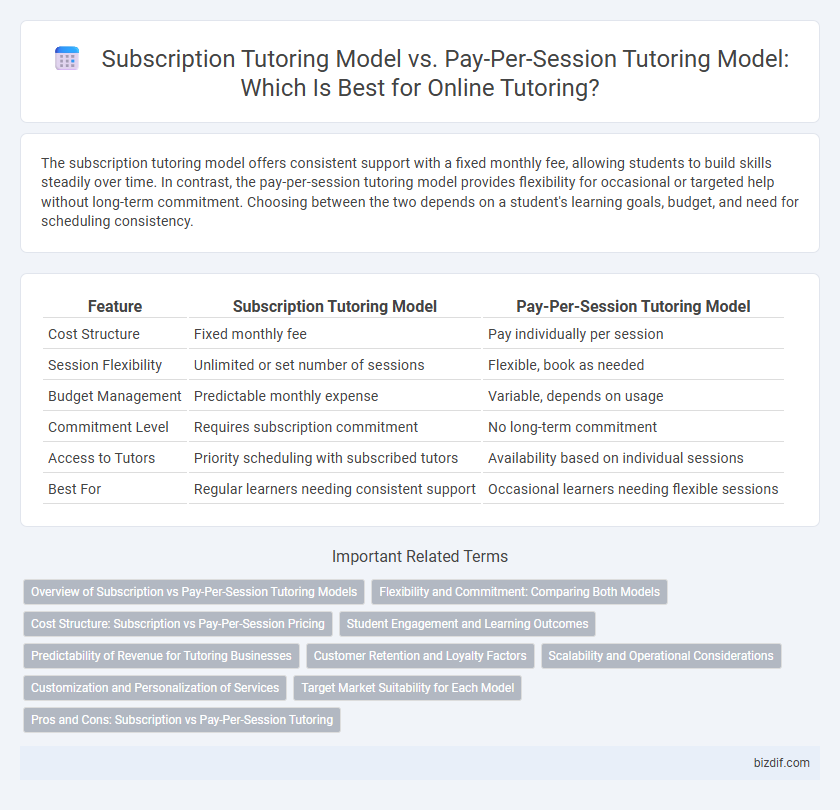The subscription tutoring model offers consistent support with a fixed monthly fee, allowing students to build skills steadily over time. In contrast, the pay-per-session tutoring model provides flexibility for occasional or targeted help without long-term commitment. Choosing between the two depends on a student's learning goals, budget, and need for scheduling consistency.
Table of Comparison
| Feature | Subscription Tutoring Model | Pay-Per-Session Tutoring Model |
|---|---|---|
| Cost Structure | Fixed monthly fee | Pay individually per session |
| Session Flexibility | Unlimited or set number of sessions | Flexible, book as needed |
| Budget Management | Predictable monthly expense | Variable, depends on usage |
| Commitment Level | Requires subscription commitment | No long-term commitment |
| Access to Tutors | Priority scheduling with subscribed tutors | Availability based on individual sessions |
| Best For | Regular learners needing consistent support | Occasional learners needing flexible sessions |
Overview of Subscription vs Pay-Per-Session Tutoring Models
The Subscription Tutoring Model offers students unlimited or a set number of sessions for a fixed monthly fee, promoting consistent learning and long-term progress. In contrast, the Pay-Per-Session Tutoring Model charges students individually for each session, allowing flexibility and budgeting based on immediate needs. Both models cater to different learning preferences and financial situations, with subscription plans encouraging commitment and pay-per-session options providing on-demand access.
Flexibility and Commitment: Comparing Both Models
The Subscription Tutoring Model offers consistent access to sessions, encouraging long-term commitment and structured progress through regular learning schedules. The Pay-Per-Session Tutoring Model provides greater flexibility by allowing students to book individual sessions as needed, ideal for those with unpredictable schedules or specific short-term goals. Choosing between these models depends on whether a student prioritizes ongoing support with committed pacing or prefers the freedom to learn on-demand without long-term obligations.
Cost Structure: Subscription vs Pay-Per-Session Pricing
The Subscription Tutoring Model offers a fixed monthly fee that provides unlimited or a set number of sessions, delivering predictable costs and often better value for consistent learners. In contrast, the Pay-Per-Session Tutoring Model charges individually for each session, allowing flexibility but leading to variable expenses that can accumulate quickly with frequent use. Evaluating cost-efficiency depends on the student's learning frequency, with subscriptions benefiting high-usage scenarios and pay-per-session suiting occasional tutoring needs.
Student Engagement and Learning Outcomes
Subscription tutoring models promote consistent student engagement by encouraging regular learning sessions, which can lead to improved retention and deeper understanding over time. Pay-per-session models offer flexibility but may result in irregular attendance, potentially hindering sustained academic progress and limiting measurable learning outcomes. Data shows that students enrolled in subscription plans often demonstrate higher achievement and greater progress tracking due to ongoing support and structured schedules.
Predictability of Revenue for Tutoring Businesses
Subscription tutoring models provide tutoring businesses with more predictable revenue streams by securing recurring payments from clients, enabling better financial planning and resource allocation. In contrast, pay-per-session models lead to fluctuating income due to varying session demand and client scheduling unpredictability. Reliable monthly subscription income reduces revenue volatility and supports consistent growth strategies for tutoring companies.
Customer Retention and Loyalty Factors
Subscription tutoring models foster higher customer retention and loyalty by offering consistent, scheduled sessions that encourage ongoing commitment and steady progress. Pay-per-session models may attract flexibility seekers but often result in lower retention due to the lack of structured engagement and perceived value. Loyalty in subscription plans is strengthened by personalized learning paths, exclusive resources, and predictable costs, enhancing long-term student-teacher relationships.
Scalability and Operational Considerations
The subscription tutoring model offers greater scalability by providing steady revenue streams and predictable scheduling, allowing tutors to efficiently manage larger student volumes. In contrast, the pay-per-session model demands more administrative oversight with variable income, complicating capacity planning and resource allocation. Operationally, subscription models streamline billing and foster long-term student commitment, while pay-per-session arrangements require continuous marketing efforts and flexible availability management.
Customization and Personalization of Services
The subscription tutoring model offers enhanced customization through continuous, tailored lesson plans that adapt to a student's progress over time, ensuring consistent skill development. In contrast, the pay-per-session model provides flexibility for one-off or sporadic tutoring needs but often lacks deep personalization due to limited session continuity. Subscription services leverage ongoing data tracking and regular feedback to personalize learning experiences more effectively than isolated pay-per-session engagements.
Target Market Suitability for Each Model
Subscription tutoring models cater predominantly to students and parents seeking consistent, long-term academic support by offering predictable costs and continuous progress tracking. Pay-per-session tutoring models appeal more to episodic learners or those requiring help in specific subjects or test preparation, providing flexibility without a long-term commitment. Market suitability hinges on customer preferences for either regular engagement or on-demand assistance, influencing retention and satisfaction rates.
Pros and Cons: Subscription vs Pay-Per-Session Tutoring
Subscription tutoring models offer consistent access to personalized learning plans and foster long-term academic progress through regular sessions, often providing cost savings compared to individual payments. Pay-per-session tutoring allows flexibility and commitment control, ideal for students needing occasional support, but may lead to higher costs over time and less continuity in learning. Choosing between these models depends on the student's frequency of need, budget constraints, and goals for sustained educational improvement.
Subscription Tutoring Model vs Pay-Per-Session Tutoring Model Infographic

 bizdif.com
bizdif.com